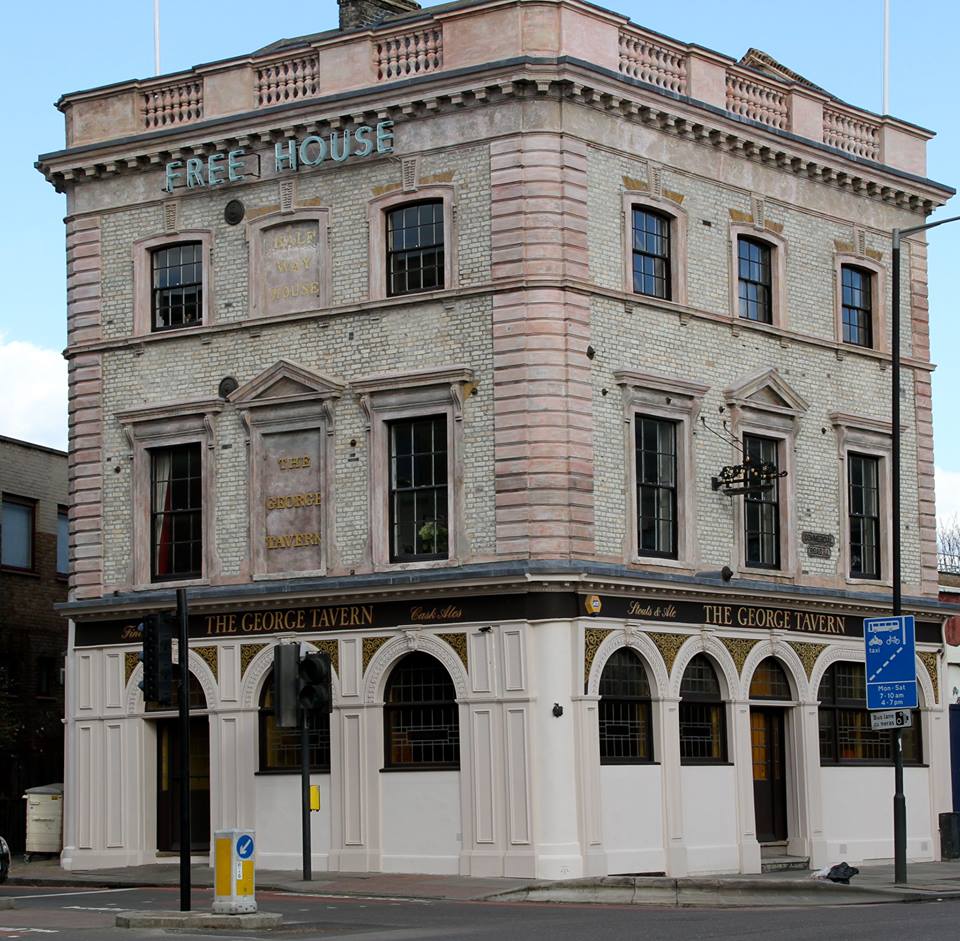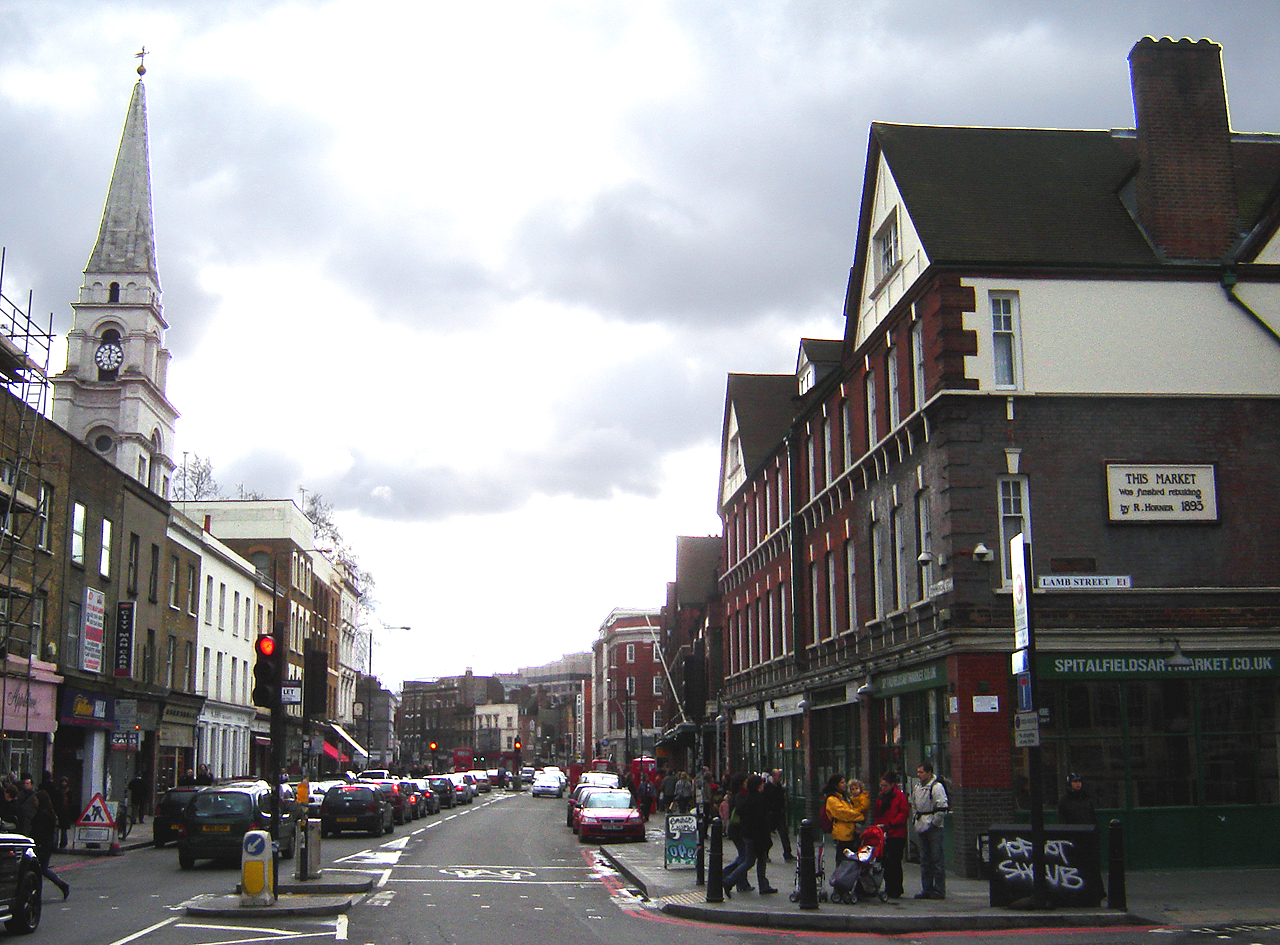|
Commercial Road
Commercial Road is a street in the London Borough of Tower Hamlets in the East End of London. It is long, running from Gardiner's Corner (previously the site of Gardiners department store, and now Aldgate East Underground station), through Stepney to the junction with Burdett Road in Limehouse at which point the route splits into the East India Dock Road and the West India Dock Road. It is an artery connecting the historic City of London with the more recently developed financial district at Canary Wharf, and part of the A13. The road contains several listed buildings. These include the George Tavern, the Troxy cinema, the Limehouse Town Hall, the former Caird and Rayner Ltd works and the Albert Gardens estate. Route Commercial Road starts at a junction with Whitechapel High Street (the A11 close to Aldgate East tube station. It heads east, crossing the Limehouse Basin, the Regents Canal and the Limehouse Cut. At Burdett Road, the road forks in two, with East India Dock ... [...More Info...] [...Related Items...] OR: [Wikipedia] [Google] [Baidu] |
Limehouse Station
Limehouse is a National Rail and connected Docklands Light Railway (DLR) station in Limehouse, London, England. It is served by regional services operated by c2c to and from Fenchurch Street, and by light metro services provided by the DLR to and from Tower Gateway or Bank. On the main line, Limehouse is located from Fenchurch Street and the following station is West Ham; on the DLR it is between Shadwell and Westferry in Travelcard Zone 2. The station was opened by the Commercial Railway (later the London and Blackwall Railway) in 1840 with the name Stepney. At that time, the Commercial Railway had a separate station named Limehouse one stop to the east. Stepney was renamed Stepney East in 1923, and in 1926 the other Limehouse station was closed. Stepney East adopted the current Limehouse name in 1987, just before the DLR opened. History Early history (1840–1866) The station was opened on 6 July 1840 by the Commercial Railway, located in the parish of Stepney within th ... [...More Info...] [...Related Items...] OR: [Wikipedia] [Google] [Baidu] |
Troxy
Troxy is a Grade II-listed Art Deco music venue on Commercial Road in Stepney, London. Built as a cinema in 1933, it closed in 1960 and became a training school for the London Opera Centre. In the 1980s the building was used as a bingo hall, and the Troxy was converted to a live events space in 2006. The building is considered a vital part of East London's history and was Grade II listed in 1990. It has a capacity of 3,100. History Opened in 1933 on the site of an old brewery, Troxy cost £250,000 to build and when it first showed films had a capacity of 3,520, making it the largest cinema in England at that time. Inside the building the cinema had luxurious seating, a revolving stage, mirror-lined restaurants and customers were served by staff wearing evening dress. To add to the sense of luxury, Troxy staff sprayed perfume during film showings. The cinema showed all the latest major releases and had a floodlit organ which rose from the orchestra pit during the interval, play ... [...More Info...] [...Related Items...] OR: [Wikipedia] [Google] [Baidu] |
Commercial Street, London
Commercial Street is an arterial road in Tower Hamlets, east London that runs north to south from Shoreditch High Street to Whitechapel High Street through the East End district of Spitalfields. The road is a section of the A1202 London Inner Ring Road and as such forms part of the boundary of the London congestion charge zone. As the name implies, Commercial Street has historically been dominated by industrial and commercial activity, which it maintains to this day. It is on the City fringes, and much industry that was seen as too noisome for the City was once exiled to such areas as this. However, since the early 1990s the street has grown increasingly fashionable, while maintaining its busy commercial feel. History Spitalfields was historically one of the poorest, most overcrowded and most crime-ridden districts in London: a parliamentary report of 1838 described this area as harbouring "an extremely immoral population; women of the lowest character, receivers of stolen go ... [...More Info...] [...Related Items...] OR: [Wikipedia] [Google] [Baidu] |
Metropolitan Board Of Works
The Metropolitan Board of Works (MBW) was the principal instrument of local government in a wide area of Middlesex, Surrey, and Kent, defined by the Metropolis Management Act 1855, from December 1855 until the establishment of the London County Council in March 1889. Its principal responsibility was to provide infrastructure to cope with the rapid growth of the metropolis, which it accomplished with varying degrees of success. The MBW was an appointed rather than elected body. This lack of accountability made it unpopular with Londoners, especially in its latter years, when it fell prey to corruption. Background The growth of an urban area around the historic City of London had rapidly accelerated with the increase in railway commuting from the 1830s onwards. However, its local government was chaotic, with hundreds of authorities having varying fields of responsibility and overlapping geographic boundaries. Providing a specific service in a given area might need the co-ordinatio ... [...More Info...] [...Related Items...] OR: [Wikipedia] [Google] [Baidu] |
London And Blackwall Railway
Originally called the Commercial Railway, the London and Blackwall Railway (L&BR) in east London, England, ran from Minories to Blackwall, London, Blackwall via Stepney, with a branch line to the Isle of Dogs, connecting central London to many of London Docklands, London's docks. It was operational from 1840 until 1926 (for passengers) and 1968 (for goods), closing after the decline of inner London's docks. Much of its infrastructure was reused as part of the Docklands Light Railway. The L&BR was leased by the Great Eastern Railway in 1866, but remained independent until absorbed into the London and North Eastern Railway at the 1923 Grouping. Another branch was opened in 1871, the Millwall Extension Railway. History It was authorised by an Act of Parliament entitled ''An Act for making a Railway from the Minories to Blackwall, with Branches, to be called "The Commercial Railway"'' dated 28 July 1836 in the reign of William IV of the United Kingdom, William IV. The length of the ... [...More Info...] [...Related Items...] OR: [Wikipedia] [Google] [Baidu] |
The Highway (London)
The Highway, part of which was formerly known as the Ratcliffe Highway, is a road in the London Borough of Tower Hamlets, in the East End of London. The route dates back to Roman times. In the 19th century it had a reputation for vice and crime and was the location of the Ratcliff Highway murders. Prior to a renaming programme of 1937, different parts of the route had different names depending on what district they were in. The name "Ratcliffe" literally means "red cliff", referring to the red sandstone cliffs which descended from the plateau on which the road was situated down to the Wapping Marshes to the south. Location The Highway runs west–east from the eastern edge of London's financial district, the City of London, to Limehouse. It runs parallel to and south of Commercial Road, the Docklands Light Railway and Cable Street, and connects East Smithfield (the street) and the Limehouse Link tunnel. Prior to the London County Council renaming programme of 1937, differe ... [...More Info...] [...Related Items...] OR: [Wikipedia] [Google] [Baidu] |
East India Docks
The East India Docks were a group of docks in Blackwall, east London, north-east of the Isle of Dogs. Today only the entrance basin and listed perimeter wall remain visible. History Early history Following the successful creation of the West India Docks which opened in 1802, an Act of Parliament in 1803 set up the East India Dock Company, promoted by the Honourable East India Company. Joseph Cotton was chairman of the Dock Company from 1803. The foundation stone was laid on 11 March 1805 and the sluices of its floating gate opened on 26 July 1806, being ready to receive ships five days later. The docks, designed by engineer Ralph Walker,Skempton, A.W. (2002) ''A Biographical Dictionary of Civil Engineers in Great Britain and Ireland'', pp. 757-758 were located to the north-east of the West India Docks. They were based on the existing Brunswick Dock, which had been used for fitting out and repairing ships as part of Blackwall Yard. The Brunswick Dock, which had originally b ... [...More Info...] [...Related Items...] OR: [Wikipedia] [Google] [Baidu] |
West India Docks
The West India Docks are a series of three docks, quaysides and warehouses built to import goods from and export goods and occasionally passengers to the British West Indies on the Isle of Dogs in London the first of which opened in 1802. Following their commercial closure in 1980, the Canary Wharf development was built around the wet docks by narrowing some of their broadest tracts. History Early history Robert Milligan, of a Scottish family, (–1809) was largely responsible for the construction of the West India Docks. He was a wealthy West Indies merchant, slave trader and ship owner, who returned to London having managed his family's Jamaica sugar plantations. Outraged at losses due to theft and delay at London's riverside wharves, Milligan headed a group of powerful businessmen, including the chairman of the London Society of West India Planters and Merchants, George Hibbert, a merchant, politician, and ship-owner, who promoted the creation of a wet dock circled by ... [...More Info...] [...Related Items...] OR: [Wikipedia] [Google] [Baidu] |
The George Tavern - 373 Commercial Road, London
''The'' () is a grammatical article in English, denoting persons or things already mentioned, under discussion, implied or otherwise presumed familiar to listeners, readers, or speakers. It is the definite article in English. ''The'' is the most frequently used word in the English language; studies and analyses of texts have found it to account for seven percent of all printed English-language words. It is derived from gendered articles in Old English which combined in Middle English and now has a single form used with pronouns of any gender. The word can be used with both singular and plural nouns, and with a noun that starts with any letter. This is different from many other languages, which have different forms of the definite article for different genders or numbers. Pronunciation In most dialects, "the" is pronounced as (with the voiced dental fricative followed by a schwa) when followed by a consonant sound, and as (homophone of pronoun ''thee'') when followed by a v ... [...More Info...] [...Related Items...] OR: [Wikipedia] [Google] [Baidu] |
London Buses Route 135
London is the capital and largest city of England and the United Kingdom, with a population of just under 9 million. It stands on the River Thames in south-east England at the head of a estuary down to the North Sea, and has been a major settlement for two millennia. The City of London, its ancient core and financial centre, was founded by the Romans as ''Londinium'' and retains its medieval boundaries.See also: Independent city § National capitals The City of Westminster, to the west of the City of London, has for centuries hosted the national government and parliament. Since the 19th century, the name "London" has also referred to the metropolis around this core, historically split between the counties of Middlesex, Essex, Surrey, Kent, and Hertfordshire, which largely comprises Greater London, governed by the Greater London Authority.The Greater London Authority consists of the Mayor of London and the London Assembly. The London Mayor is distinguished from the Lord Mayo ... [...More Info...] [...Related Items...] OR: [Wikipedia] [Google] [Baidu] |
Limehouse Cut
The Limehouse Cut is a largely straight, broad canal in the East End of London which links the lower reaches of the Lee Navigation to the River Thames. Opening on 17 September 1770, and widened for two-way traffic by 1777, it is the oldest canal in the London area. Although short, it has a diverse social and industrial history. Formerly discharging directly into the Thames, since 1968 it has done so indirectly by a connection through Limehouse Basin. The Cut is about long. It turns in a broad curve from Bow Locks, where the Lee Navigation meets Bow Creek; it then proceeds directly south-west through the London Borough of Tower Hamlets, finally making a short hook to connect to Limehouse Basin. Origins Before the Cut Already in Elizabethan times there was a vigorous river trade between towns on the River Lea and the City of London, but watermen had to await the tides and row round the Isle of Dogs. Thus in 1588 (wrote G. B. G. Bull): The goods came from even further ... [...More Info...] [...Related Items...] OR: [Wikipedia] [Google] [Baidu] |
Regents Canal
Regent's Canal is a canal across an area just north of central London, England. It provides a link from the Paddington Arm of the Grand Union Canal, north-west of Paddington Basin in the west, to the Limehouse Basin and the River Thames in east London. The canal is long. History First proposed by Thomas Homer in 1802 as a link from the Paddington arm of the then Grand Junction Canal (opened in 1801) with the River Thames at Limehouse, the Regent's Canal was built during the early 19th century after an Act of Parliament was passed in 1812. Noted architect and town planner John Nash was a director of the company; in 1811 he had produced a masterplan for George IV, then Prince Regent, to redevelop a large area of central north London – as a result, the Regent's Canal was included in the scheme, running for part of its distance along the northern edge of Regent's Park. As with many Nash projects, the detailed design was passed to one of his assistants, in this case Jame ... [...More Info...] [...Related Items...] OR: [Wikipedia] [Google] [Baidu] |









.png)
.png)
